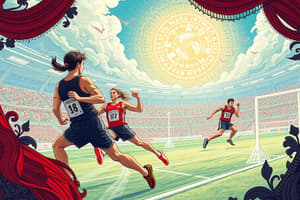Podcast
Questions and Answers
In a bunch start, where is the kneeling knee positioned in relation to the front foot?
In a bunch start, where is the kneeling knee positioned in relation to the front foot?
- Aligned with the heel of the front foot
- Slightly ahead of the front foot (correct)
- On the same line as the front foot
- Behind the front foot
What is a requirement for the baton exchange during a relay race?
What is a requirement for the baton exchange during a relay race?
- Must occur within a 30-meter passing zone
- Can be completed anywhere on the track
- Always requires a visual pass
- Must be done within a 20-meter passing zone (correct)
During a relay race, what happens if a runner drops the baton?
During a relay race, what happens if a runner drops the baton?
- Another runner must retrieve it
- The baton must be passed to the next runner immediately
- The race is automatically disqualified
- The runner must pick it up himself (correct)
What is the main difference between a visual and a non-visual pass in baton exchange?
What is the main difference between a visual and a non-visual pass in baton exchange?
In a good elongated start, the kneeling knee should be positioned where?
In a good elongated start, the kneeling knee should be positioned where?
Which style in the shot put involves a pivot turn and crosses the legs?
Which style in the shot put involves a pivot turn and crosses the legs?
What is the weight of the shot put used by women?
What is the weight of the shot put used by women?
In the discus throw, how must the discus be released?
In the discus throw, how must the discus be released?
Which of the following is NOT one of the recommended styles for the discus throw?
Which of the following is NOT one of the recommended styles for the discus throw?
What is the diameter range of the discus used by men?
What is the diameter range of the discus used by men?
What is the correct way a jumper should initiate a jump?
What is the correct way a jumper should initiate a jump?
Which style requires the jumper to reverse their body into a 180-degree turn during bar clearance?
Which style requires the jumper to reverse their body into a 180-degree turn during bar clearance?
In long jump, what is the primary goal for the jumper?
In long jump, what is the primary goal for the jumper?
Which of the following adopts the outer foot as the take-off leg?
Which of the following adopts the outer foot as the take-off leg?
Which technique focuses on taking steps while airborne to increase distance?
Which technique focuses on taking steps while airborne to increase distance?
What are the three components of the triple jump?
What are the three components of the triple jump?
What is the primary action used in the shot put technique?
What is the primary action used in the shot put technique?
What happens if a javelin thrower steps beyond the circle during a throw?
What happens if a javelin thrower steps beyond the circle during a throw?
Which of the following is NOT a requirement for throwing events?
Which of the following is NOT a requirement for throwing events?
What is a recommended technique for beginners in javelin throwing?
What is a recommended technique for beginners in javelin throwing?
What term is currently widely used to refer to the field of physical education?
What term is currently widely used to refer to the field of physical education?
Which article of the Philippine Constitution emphasizes the promotion of physical education?
Which article of the Philippine Constitution emphasizes the promotion of physical education?
What is the purpose of Proclamation Order No. 406?
What is the purpose of Proclamation Order No. 406?
What does Executive Order No. 64 focus on?
What does Executive Order No. 64 focus on?
Which legal document asserts that physical fitness remains part of the basic education program?
Which legal document asserts that physical fitness remains part of the basic education program?
What is the significance of the Olympic Flame in the modern Olympic Games?
What is the significance of the Olympic Flame in the modern Olympic Games?
Which statement best represents the Olympic motto?
Which statement best represents the Olympic motto?
What do the five interconnected rings in the Olympic symbol represent?
What do the five interconnected rings in the Olympic symbol represent?
What was the major change regarding the Olympic mascot introduced in 1968?
What was the major change regarding the Olympic mascot introduced in 1968?
What concept does the Official Olympic Creed emphasize?
What concept does the Official Olympic Creed emphasize?
What should happen during a baton exchange in a relay race?
What should happen during a baton exchange in a relay race?
What is a consequence if a runner drops the baton during a relay race?
What is a consequence if a runner drops the baton during a relay race?
In a good elongated start, where should the runner's kneeling knee be positioned?
In a good elongated start, where should the runner's kneeling knee be positioned?
Which of the following styles in the shot put requires a pivot turn?
Which of the following styles in the shot put requires a pivot turn?
What is the diameter of the discus used by men in competitions?
What is the diameter of the discus used by men in competitions?
What is the best time to determine resting heart rate?
What is the best time to determine resting heart rate?
How is Personal Maximal Heart Rate (PMHR) calculated?
How is Personal Maximal Heart Rate (PMHR) calculated?
What percentage range does the Training Heart Rate (THR) fall within relative to PMHR?
What percentage range does the Training Heart Rate (THR) fall within relative to PMHR?
When should Recovery Heart Rate (RHR) be taken after training?
When should Recovery Heart Rate (RHR) be taken after training?
Which definition best describes 'sports'?
Which definition best describes 'sports'?
What is dehydration?
What is dehydration?
What does frequency refer to in the context of physical activity?
What does frequency refer to in the context of physical activity?
What is the purpose of dynamic stretching?
What is the purpose of dynamic stretching?
What does heart rate reserve (HRR) measure?
What does heart rate reserve (HRR) measure?
Which statement best describes overtraining?
Which statement best describes overtraining?
What does overload imply in fitness training?
What does overload imply in fitness training?
What is the primary component of performance-related fitness?
What is the primary component of performance-related fitness?
What does static stretching involve?
What does static stretching involve?
What was the focus of athletic training in ancient civilizations like Greece and Rome?
What was the focus of athletic training in ancient civilizations like Greece and Rome?
Which event was featured in the first recorded Olympic Games?
Which event was featured in the first recorded Olympic Games?
What innovation has significantly contributed to reducing lap times in athletics?
What innovation has significantly contributed to reducing lap times in athletics?
Which high jump technique is associated with Dick Fosbury?
Which high jump technique is associated with Dick Fosbury?
What factor has contributed to increased performance levels in athletics?
What factor has contributed to increased performance levels in athletics?
Who is recognized as one of the fastest women in Asia for nearly a decade?
Who is recognized as one of the fastest women in Asia for nearly a decade?
Which of the following athletes is known for excellence in the pole vault?
Which of the following athletes is known for excellence in the pole vault?
Which factor is a modern aspect of athletics that allows athletes to earn money?
Which factor is a modern aspect of athletics that allows athletes to earn money?
Flashcards are hidden until you start studying
Study Notes
Starting Positions
- Bunch Start: The runner's kneeling knee is placed slightly ahead of their front foot.
- Elongated Start: The runner's kneeling knee is placed behind or aligned with the heel of their front foot.
Relay Races
- Relay Races: Four runners pass a baton between each other.
- Passing the Baton: Can be visual or non-visual.
- Baton Exchange: Must happen within a 20-meter passing zone, with the center marked.
Shot Put
- Thrower uses an iron/brass shot, starting in a standing position.
- Glide is performed to generate power.
- Three Recommended Glide Styles:
- Hop: The thrower faces the end of the circle's diameter, hopping with their rear foot.
- Parry O'Brien style: Thrower faces the opposite direction for a wider shoulder arc.
- Revolving style: Thrower performs a pivot turn at the top of the circle.
Discus Throw
- Thrower uses a saucer-like discus, with a flat palm and fingers grasping the edge.
- Preliminary swing may precede release.
- Discus must spin clockwise, with the index finger releasing last.
- Two Recommended Styles:
- 90 degrees style
- Revolving style
Weights Specifications for Throwing Events
- Shot Put:
- Men's weight: 7.60 kg
- Women's weight: 4.00 kg
- Diameter: 110-130 mm for men, 95-110 mm for women
- Discus Throw:
- Men's weight: 2.00 kg
- Women's weight: 1.00 kg
- Javelin Throw:
- Men's weight: 800 g
- Women's weight: 600 g
- Men's length: 2.60-2.70 m
- Women's length: 2.20-2.30 m
Basic Skills in Field Events
- Common Characteristics of Jumping Events:
- Only one foot is used in the jump.
- Somersaulting is not permitted.
- Approach run builds speed from the take-off mark.
- Jump initiates at a mark/take-off board, converting horizontal velocity upward/forward.
- Landing occurs after the jump/bar clearance in a designated pit.
High Jump
- Four Recommended Styles:
- Scissor Cut Style: Approach run from center/sides, lead leg at the bar center, body leans backward during clearance, landing with the lead leg.
- Western Roll Style: Approach run from left/right side, inside foot for take-off, jumper reverses body by 180 degrees during clearance.
- Belly Roll Style: Similar to Western Roll, but body reverses by 180 degrees during clearance.
- Fosbury Style: Approach from center towards one upright post, take-off with outer foot, landing on shoulder.
Long Jump
- Jumper aims for maximum distance by building speed and converting horizontal velocity upward/forward.
- Foot must contact the take-off board.
- Two Recommended Styles:
- Hang on the air: Maintaining a suspended position to delay landing.
- Hitch kick: Taking steps airborne to cover more distance.
Triple Jump
- Combination of three jumps:
- Hop: One-foot jump landing on the same foot.
- Step: One-foot jump landing on the other foot.
- Jump: One-foot jump landing on both feet.
Pole Vault
- Athletes use a pole to achieve height and clear a crossbar.
Throwing Events
- Common Requirements:
- Approach run (javelin), glide (shot put), turn (discus)
- Standing throwing position after approach.
- Skills:
- Javelin: Pull from the back
- Shot put: Push from the shoulder
- Discus: Swing from the side
- Other Requirements:
- Follow-through after release
- Only one arm for throwing
- Stepping beyond the circle/scratch line is a foul in javelin.
- Exiting towards the rear half of the circle/scratch line after the throw.
Javelin Throw
- Fundamentals:
- Standing throwing position
- Javelin held in shoulder/underhand carry
- Place one foot in front of the other
- Bend upper body backwards, non-throwing arm bent at chest level
- Release the javelin forward
- Throwing Styles:
- Hop-change step: Hop followed by foot position exchange.
- Rear cross: Stepping forward, crossing rear leg behind the front leg
Nature of Physical Education
- Alternative names:
- Movement Education
- Sports Education
- Motor Education
- Physical Fitness
- Human Kinetics
- Currently, "Physical Education and Sports" is widely used.
Legal Basis for Teaching Physical Education and Sports
- Philippine Constitution (1987):
- Article II, Section 17: State prioritizes education, sports, etc. to promote nationalism.
- Article XIV, Section 19: State promotes physical education, encourages sports programs, and includes training for international competition to foster self-discipline, teamwork, and a healthy citizenry.
- Philippine Government Orders:
- Proclamation Order No. 406: 1990 to 2001 declared "Decade of Physical Fitness and Sports."
- Executive Order No. 63: Created National Physical Fitness and Sports Development Council.
- Executive Order No. 64 : National Policy and Program of "Sports for All."
- International Declarations:
- Article I, U.N.E.S.C.O.: Practice of physical education and sports is a fundamental right.
- Department of Education, Culture, and Sports (D.E.C.S.):
- D.E.C.S. Order No. 84: Physical education and school sports are a priority.
- Philippine Law:
- Republic Act 9155 - Basic Education Act of 2002: Physical fitness and school sports are part of basic education.
- United Nations:
- United Nation Declaration: Declared 2005 as the International Year of Sports and Physical Education.
The Olympic Games
I. History of the Olympic Games
- Ancient Origins: Legends say the games originated with Heracles, who built the Olympic Stadium in honor of Zeus.
- Prehistoric Roots: Athletics has prehistoric roots, with running, jumping, and throwing integral to daily life and celebrations.
- The Homeric Age: The Olympics emerged during the Homeric age, beginning in 776 B.C., held every four years.
II. Modern Olympic Games
- Olympic Flame: Lit in Olympia, carried by runners in a relay to the host city for the opening ceremonies.
- Olympic Mascot: An animal or human figure representing the host country's heritage, used since 1968.
- Five Olympic Rings: Interconnected rings symbolize the unity of the five continents, adopted in 1913, debuted in 1920.
- Olympic Motto: "Citius, Altius, Fortius" (Faster, Higher, Stronger)
- Official Olympic Creed: The most important element of the Olympics is not winning but participating.
III. Athletics
- Definition: Athletics is a sport encompassing running, jumping, and throwing events.
- Brief Ancient History: Athletics has prehistoric roots, evolving from practical activities into formalized games and festivals in ancient Greece. They eventually evolved into the Olympic games.
Exercise and Fitness Terminology
Health-Related Fitness Terms
- Dehydration: Loss of excessive fluid from the body.
- Duration: Length of exercise.
- Dynamic Stretching: Stretching with bouncing and bobbing movements.
- Exercise Heart Rate: Heart rate needed for aerobic activity improvement.
- Frequency: Number of times per week one participates in physical activity.
- Gynoid Obesity: Feminine pattern of fat deposition in the hips, buttocks, and thighs.
- Health Promotion: Encouraging healthy lifestyle behaviors.
- Health-Related Fitness: Focuses on cardio respiratory endurance, muscular strength and endurance, flexibility, and lean body composition.
- Heart Rate Reserve (HRR): Difference between maximal heart rate and resting heart rate.
- Hypertension: High blood pressure.
- Hypothermia: Excessive heat loss from the body.
- Intensity: Amount of energy expended during exercise.
- Aschemia: Diminished blood flow to the heart.
- Lipids: "Fat."
- Maximal Heart Rate (MHR): Highest heart rate for a person, related to aerobic capacity.
- Myocardial Infarction: Heart attack.
- Obesity: Chronic disease with excess body fat.
- Overload: Subjecting body systems to greater physical demand for muscle development.
- Overtraining: Physiological and psychological staleness caused by exclusive exercise.
- Overweight: Excessive body weight for height.
Performance-Related Fitness Terms
- Performance-related fitness: enables proficiency in physical skills.
- Physical Activity: Physical movement with energy expenditure and health benefits.
Training Principles
- Progression: Increasing physical demands on the body.
- Specificity of Training: Training specific muscles for desired improvement.
- Static Stretching: Holding muscle positions for 15-30 seconds.
- Target Heart Rate: Heart rate during aerobic exercise for improvement.
- Ventilation: Air moved in and out of the lungs per minute.
Athletics
- History: Athletics is as old as history, with running, jumping, and throwing used in hunting and war.
- Early Use: Running was part of military training for the ancient Greeks, Persians, and Romans.
- Contests: Contests for speed, strength, and agility emerged, including the first recorded Olympic Games (approx. 776 B.C.) which featured a 205-meter footrace.
- Additional Events: Over time, other events were added (long jump, javelin throw, hammer throw, triple jump).
- Informal Events: These events evolved from informal sports days in Ireland, England, and Scotland.
- Popular 18th and 19th Centuries: Sprinting and distance running were popular, evolving into organized competitions with professional participants and betting.
Athletics Development Factors
- Increased Competition, especially in Europe
- Improved Training Methods: Strength training with weights, synthetic tracks, fiberglass vaulting poles.
- The Fosbury Flop: Increased jump height significantly.
- Athlete Earnings: Opportunities to earn money through product endorsements and invitational events.
Current Athletics Champions
- Men: Carl Lewis (USA, sprinting), Edwin Moses (USA, hurdles), Said Aouita (Morocco, distance), Sebastian Coe (Great Britain, distance), Sergey Bubka (Soviet Union, pole vault), and Daley Thompson (Great Britain, decathlon).
- Women: Marita Koch (East Germany, sprinting), Heike Drechsler (East Germany, sprinting & long jump), Florence Griffith Joyner (USA, sprinting), and Jackie Joyner-Kersee (USA, long jump & heptathlon).
- Asia: Lydia de Vega (Philippines) was Asia's fastest woman for nearly a decade.
Different Kinds of Heart Rate
- Resting Heart Rate: Heart rate at rest, ideally measured right after waking up.
- Theoretical Maximal Heart Rate (THMR): Highest heart rate attainable.
- Personal Maximal Heart Rate (PMHR): Computed from THMR based on age.
- Training Heart Rate (THR): 60-80% of PMHR.
- Recovery Heart Rate (RHR): Heart rate 90 seconds after training, to assess the need for overload.
Definitions
- Play: To take part in a game or games.
- Game: Contest played according to rules.
- Sports: Games or competitive activities involving physical exertion and skills.
Studying That Suits You
Use AI to generate personalized quizzes and flashcards to suit your learning preferences.




